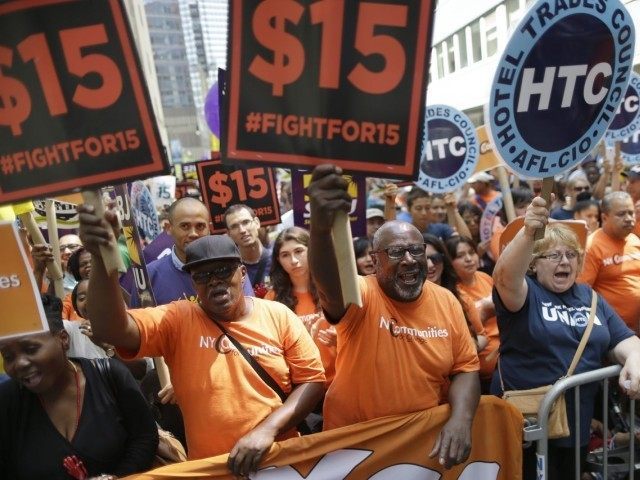Although the City of Seattle launched the “$15 For All” minimum wage movement in 2014 to help the poor and cut government welfare spending, new research reveals that the minimum wage increases unemployment and causes welfare spending to spike higher.
The Democratic Party’s platform “justified” raising the minimum wage to $15 an hour, not only as a humanitarian effort to help low wage workers, but also supposedly to help cut the $1 trillion federal, state and local government welfare budget.
According to the Employment Policy Institute, each $1 increase for the minimum wage will shrink government welfare spending by $155 a month because of the “means-testing” requirements of the Earned Income Tax Credit, the refundable portion of the Child Tax Credit; the SNAP food stamp program; the Low Income Home Energy Assistance Program; the Supplemental Nutrition Program for Women, Infants, and Children; the Section 8 Housing Choice Voucher program; Medicaid; and the Temporary Assistance for Needy Families program cash assistance programs.
Seattle’s minimum wage law became effective in April of 2015, resulting in an initial minimum wage increase for large companies from $9.32 per hour to $11. The minimum wage will increase to $13 an hour on January 1, 2016 and $15 on January 1, 2017.
With Seattle’s economy, wages and employment rising since the move, unions have trumpeted Seattle as proof that raising the minimum wage does not result in “economics textbook” job losses, reduced hours for workers, or negative impact on local economies.
But Moody’s Analytics has commented, “Simply showing that Seattle added jobs after the minimum wage hike does not disprove job losses.” The real test according to Moody’s is what would have happened without the 20 percent minimum wage increase.
The University of Washington was tasked with calculating the short-run effects of Seattle’s minimum wage increase. They concluded that after 14 months, while the minimum wage law had increased wages for some workers, “the Seattle Minimum Wage Ordinance appears to have lowered employment rates of low-wage workers.”
On a “cost benefit analysis” of the minimum wage, the researchers found, “the effects of dis-employment appear to be roughly offsetting the gain in hourly wage rates, leaving the earnings for the average low-wage worker unchanged.”
Furthermore, the UW study warned that “negative unintended consequences …[are] concerning and need to be followed closely in future years because the long-run effects are likely to be greater as businesses and workers have more time to adapt to the ordinance.”
Although average net compensation costs for Seattle employers is still about the same, the big minimum wage increases for some workers are being paid for by big reductions in the number of jobs and hours worked by other, now poorer, workers.
For the cost of government welfare spending, the unintended consequence of higher unemployment for low-wage workers will soon cause a dollar-for-dollar spike in the government welfare spending that will only get bigger as employers seek to automate away more low-pay jobs.

COMMENTS
Please let us know if you're having issues with commenting.